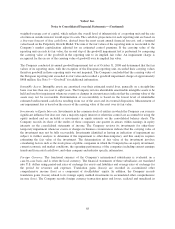Yahoo 2008 Annual Report Download - page 71
Download and view the complete annual report
Please find page 71 of the 2008 Yahoo annual report below. You can navigate through the pages in the report by either clicking on the pages listed below, or by using the keyword search tool below to find specific information within the annual report.Yahoo! Inc.
Notes to Consolidated Financial Statements—(Continued)
These awards are expensed under an accelerated amortization approach using the same fair value measurements
which were used in calculating pro forma stock-based compensation expense under SFAS No. 123, “Accounting
for Stock-Based Compensation.” For stock-based awards granted on or after January 1, 2006, the Company
records stock-based compensation expense on a straight-line basis over the requisite service period, generally one
to four years.
Calculating stock-based compensation expense requires the input of highly subjective assumptions, including the
expected term of the stock options, stock price volatility, and the pre-vesting forfeiture rate of stock awards. The
Company estimates the expected life of options granted based on historical exercise patterns, which the Company
believes are representative of future behavior. The Company estimates the volatility of its common stock on the
date of grant based on the implied volatility of publicly traded options on its common stock, with a term of one
year or greater. The Company believes that implied volatility calculated based on actively traded options on its
common stock is a better indicator of expected volatility and future stock price trends than historical volatility.
The assumptions used in calculating the fair value of stock-based awards represent the Company’s best estimates,
but these estimates involve inherent uncertainties and the application of management judgment. As a result, if
factors change and the Company uses different assumptions, the Company’s stock-based compensation expense
could be materially different in the future. In addition, the Company is required to estimate the expected
pre-vesting award forfeiture rate, as well as the probability that performance conditions that affect the vesting of
certain awards will be achieved, and only recognize expense for those shares expected to vest. The Company
estimates the forfeiture rate based on historical experience of the Company’s stock-based awards that are granted
and cancelled before vesting. If the Company’s actual forfeiture rate is materially different from the Company’s
original estimate, the stock-based compensation expense could be significantly different from what the Company
has recorded in the current period. Changes in the estimated forfeiture rate can have a significant effect on
reported stock-based compensation expense, as the effect of adjusting the forfeiture rate for all current and
previously recognized expense for unvested awards is recognized in the period the forfeiture estimate is changed.
If the actual forfeiture rate is higher than the estimated forfeiture rate, then an adjustment will be made to
increase the estimated forfeiture rate, which will result in a decrease to the expense recognized in the financial
statements. If the actual forfeiture rate is lower than the estimated forfeiture rate, then an adjustment will be
made to lower the estimated forfeiture rate, which will result in an increase to the expense recognized in the
financial statements. See Note 12—“Employee Benefits” for additional information.
The Company uses the “with and without” approach as described in EITF Topic No. D-32 in determining the
order in which tax attributes are utilized. As a result, the Company only recognizes a tax benefit from stock-
based awards in additional paid-in capital if an incremental tax benefit is realized after all other tax attributes
currently available to the Company have been utilized. In addition, the Company accounts for the indirect effects
of stock-based awards on other tax attributes, such as the research tax credit, through the income statement.
Operating and Capital Leases. The Company leases office space and data centers under operating leases and
certain data center equipment under capital lease agreements with original lease periods up to 23 years. Assets
acquired under capital leases are amortized over the shorter of the remaining lease term or its estimated useful
life which is generally ten to fifteen years. Certain of the lease agreements contain tenant improvements, rent
holidays, and rent escalation provisions. For purposes of recognizing these lease incentives on a straight-line
basis over the term of the lease, the Company uses the date of initial possession to begin amortization. Lease
renewal periods are considered on a lease-by-lease basis and are generally not included in the period of straight-
line recognition. For the year ended December 31, 2008, the Company expensed approximately $3 million of
interest and recorded less than $1 million of accumulated amortization in connection with the capital lease.
Income Taxes. Deferred income taxes are determined based on the differences between the financial reporting
and tax bases of assets and liabilities and are measured using the currently enacted tax rates and laws. The
65
























